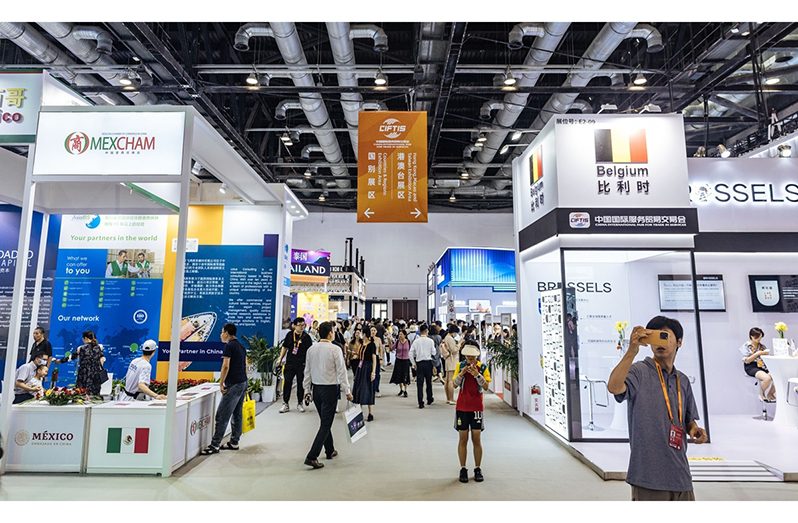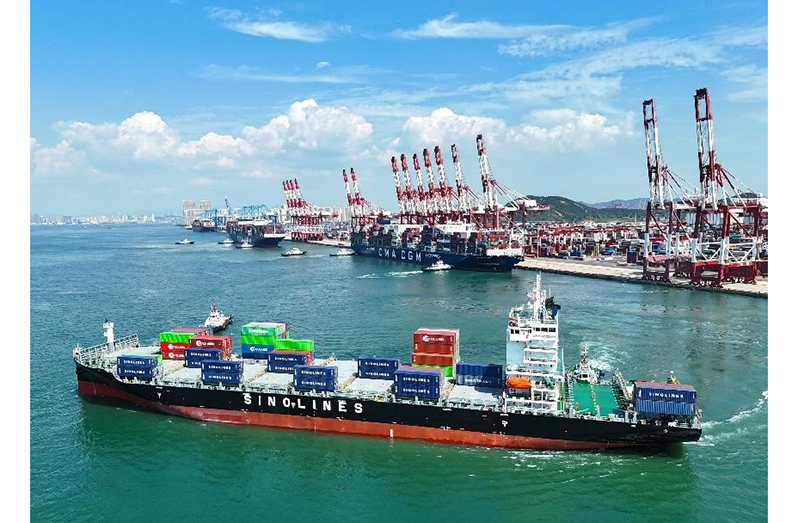amid robust trade, economic relations
LATIN American countries are seizing opportunities at the 2023 China International Fair for Trade in Services (CIFTIS), the world’s largest services trade fair, to promote win-win co-operation to add new growth drivers to the fast-developing economic and trade relationship.
Commerce officials from the Dominican Republic, Ecuador, Mexico, Uruguay and Colombia took opportunities and platforms at the 2023 CIFTIS to promote their countries’ most appealing products and services, and sought to attract Chinese investment at a sub-forum on Tuesday.
In recent years, China’s trade and economic co-operation with Latin America has moved onto a fast track of development.
In 2021, China’s trade with Latin American countries exceeded $450 billion for the first time, with a 41 per cent year-on-year increase. In 2022, trade further increased to $485.8 billion.
In the first seven months of this year, trade with Latin America grew by 5.5 per cent with efforts to diversify markets and improve related infrastructure despite sluggish global demand.
China’s trade with Latin America was also blessed with the joining of the China-proposed Belt and Road Initiative by Argentina and Nicaragua in 2022.
With Nicaragua becoming a free trade partner just days ago, China now has five free trade partners in Latin America.
Chinese investment in a number of Latin American countries has grown rapidly in recent years.
Chinese foreign direct investment in Mexico totalled $2.16 billion from 1999-2022, but $900 million, or 43 per cent of the total, was done in the past four years, according to Santiago Toledo Teja, Commercial Counselor of the Mexican Embassy in Beijing.
Another $2 billion was in the pipeline as of 2023, according to the Mexican trade official.
Jorge Cevallos, Commercial Counsellor of the Ecuadorian Embassy, told the Global Times on Tuesday that there is great potential for China and Ecuador to engage in services trade co-operation.
“So far, we have been focusing on trade of goods. But services have a lot of room to grow. Tourism services, engineering consultancy services, a range of services related to the digital economy, both for logistics and for other kinds of digital payment platforms, as well as translation services, and plenty of different areas,” said Cevallos.
Cevallos emphasised that the free trade agreement between China and Ecuador, signed on May 11 this year, has a chapter devoted to e-commerce, which makes Ecuador the first Latin American country to include a chapter of this nature in a trade agreement with China.
“We’re actually very happy to have it – China has a lot of development in that area, China is the leader in the development of a different kind of communication, different services related to the digital economy, through which Ecuador can benefit. We have a strong base of software engineers, so we can develop solutions together in order to have our customers better served,” Cevallos said.
More could be done to further an already deepening trade and economic relationship, Latin American trade officials at the seminar said.
“In Colombia, you could hail a car with a Xiaomi phone using a mobile app offered by Didi, and in a few years’ time, take a subway built by Chinese infrastructure giant China Harbour Engineering Company and operated by a Xi’an-based Chinese subway operator,” Shi Hui, senior investment advisor of ProColombia China, said at the seminar.
Shi said in addition to Colombia’s coffee, cocoa and timber, co-operation in fintech, movies and gaming also has great potential. “In 2022, China overtook Japan as Colombia’s top foreign investor from Asia.”
“By the way, the design of swimming suits and underwear in Colombia really deserves Chinese companies’ attention,” Shi said, noting the exotic Caribbean taste.
Port of Guangzhou, the world’s fifth-largest port, on Monday launched a new regular shipping route to Brazil, the fifth international marine route the port developed with BRICS countries this year.
BRI a ‘path of happiness’ benefitting world
CHINA will host the third Belt and Road Forum for International Co-operation in Beijing this October.
The forum is not only the highlight in commemorative events to mark the 10th anniversary of the Belt and Road Initiative (BRI), but also an important platform for all partners to plan high-quality Belt and Road co-operation.
China will take the holding of the forum as an opportunity to take stock of what it has achieved, chart the course for the future, and guide the continuous advancement of high-quality BRI co-operation. It will open up a chapter in the new era for the Silk Road featuring mutual benefit and win-win results between countries, friendship and cultural affinity between peoples and mutual learning between civilizations.
In September and October of 2013, Chinese President Xi Jinping proposed the building of the Silk Road Economic Belt and the 21st Century Maritime Silk Road in Kazakhstan and Indonesia respectively, ushering in a new era of international co-operation.
Over the past 10 years, the BRI has evolved from broad strokes to refined details, becoming the most popular international public good and largest-scale international co-operation platform.
Over the past 10 years, adhering to the principle of extensive consultation, joint contribution and shared benefits, the initiative has made fruitful achievements. It has been joined by more than three-quarters of countries in the world, established over 3,000 co-operation projects, mobilised nearly $1 trillion of investment worldwide and created 420,000 jobs for participating countries.
These achievements fully prove that the BRI is a “path of happiness” that benefits the whole world.
Based on win-win co-operation, the “path of happiness” is becoming wider.
In the past decade, a series of landmark projects have been built under the BRI, including the China-Europe freight train, the new western land-sea corridor, the China-Laos Railway, and the Piraeus port. A solid foundation has been laid for developing economic, trade and production capability co-operation and expanding energy and resource co-operation.
Looking around the world, the Norochcholai Coal Power Plant in Puttalam is supplying electricity for thousands of Sri Lankan families, the Mombasa-Nairobi Standard Gauge Railway in Kenya has boosted local economic growth by over two percentage points, and the Chinese vocational workshop program Luban Workshop has offered vocational training for young people in over 20 countries.
These have created an array of national landmarks, livelihood projects, and milestones of co-operation, injecting new impetus into participating countries.
A report issued by Brussels-based economic think tank Bruegel, which analysed the global public opinion’s concern and sentiment towards the BRI based on data from mainstream media reports of nearly 150 countries, noted that the initiative is viewed positively in most parts of the world.
Following green and innovative development, the “path of happiness” is making the world more beautiful.
From the BRI International Green Development Coalition and the Green Silk Road Envoys Program, to the Initiative for Belt And Road Partnership on Green Development, green development has become a defining feature of high-quality BRI co-operation.
Former Under-Secretary-General of the UN Erik Solheim said that the BRI has become the biggest driving force for global green development.
As a new round of sci-tech revolution and industrial transformation continues to evolve, BRI partners have worked actively to carry out international co-operation in emerging areas such as the digital economy. The Digital Silk Road is becoming a digital bridge facilitating a new type of globalisation, and the connotation of the BRI is being continuously enriched.
Surakiart Sathirathai, former deputy prime minister of Thailand, said that Belt and Road co-operation has not only enhanced infrastructure connectivity, but also promoted people-to-people exchanges, cross-cultural communication and digital economy co-operation. It is conducive to building an open world economy and promoting global development and prosperity, he added.
All parties are looking forward to the upcoming third Belt and Road Forum for International Co-operation, to further plan high-quality Belt and Road co-operation and energise the building of a global community of development with a shared future.
The forum is the top-level platform for international co-operation under the framework of the BRI, and an important platform for all partners to plan high-quality Belt and Road co-operation and share the benefits of mutually beneficial co-operation.
After the previous two forums, relevant parties have established a series of multilateral dialogue and co-operation platforms under the framework of the BRI, which fully demonstrated the concept, mechanism and measures of Belt and Road co-operation. Co-operation opportunities will be further expanded with the forum.
As a new decade of the BRI begins, the third Belt and Road Forum for International Co-operation will further consolidate international consensuses, draw a blueprint for co-operation, pave a wide path toward common development, and build bright prospects of green development, pushing for high-quality Belt and Road co-operation.





.jpg)









